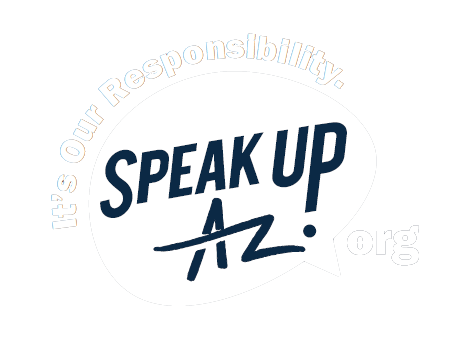Unemployment Insurance Common Terms and Abbreviations
Additional Claim
When there is a break in filing within an active benefit year and the claimant wishes to resume filing weekly claims for benefits after having returned to work with a previous or new employer. Note: A re-opened claim occurs when the break in filing is for reasons other than a return to work with a previous or new employer.
Adjudication/Adjudicator
Adjudication is the process the Unemployment Insurance Program uses to resolve issues (see below for definition). The individual who completes the fact gathering which involves interviewing the claimant and possibly an employer for whom the individual worked, is called an adjudicator.
Appeal
The formal request by an Unemployment Insurance claimant or employer to have a decision, determination, or notice reconsidered by the next higher level of authority.
Arizona UI Tax Reporting for Employers (AZURE)
Arizona UI Tax Reporting for Employers is used by employers to upload a single or multiple quarterly Unemployment Tax and Wage Reports and submit ACH credit payments. View the AZURE User Requirements for more information.
Back Pay Award
Includes but not limited to, awards (1) under the Fair Labor Standards Act for unpaid overtime or minimum wages, but not for liquidated damages thereunder: and (2) of the National Labor Relations Board or by private agreement consent or arbitration for loss of pay by reason of wrongful discharge.
Base Period
The Base Period is the first four of the last five completed calendar quarters before an application for benefits is filed. Insured wages paid during this period determine the amount of benefits an unemployment insurance claimant may be eligible to receive (insurance wages are wages earned from an employer who pays unemployment insurance taxes). Visit our Unemployment Insurance Benefits Definitions - Base Period page for more information.
Benefit Week Ending (BWE)
Consists of a period of seven consecutive days beginning at Midnight Sunday and ending 11:59:59 pm the following Saturday night. The weekly claim filing process (also referred to as weekly certification) is used to verify that a UI claimant was unemployed during the week and eligible to receive benefit payments. Weekly claims are filed by individuals who have applied for Unemployment Insurance (UI) Benefits and/or have an existing Arizona Unemployment Insurance Claim with a monetary balance (meaning, money still remains in the still have money remaining in your total benefit entitlement).
Benefit Year
The twelve-month period beginning the Sunday of the week in which an insured worker files an initial application for benefits. Weekly claims for benefit payments may be filed during this twelve-month period until the maximum benefit award is reduced to zero or the benefit year has ended (whichever occurs first). During this period the claimant can receive 26 weeks of benefits, provided they have earned sufficient wages in their base period and have also met all other eligibility requirements.
Benefit Year Ends (BYE)
The ending date of a claim referred to as BYE or benefit year ends. The Saturday date which ends the twelve-month period of a claim in which a claimant may receive unemployment benefits, if eligible.
Calendar Quarter
The period of three consecutive calendar months ending March 31, June 30, September 30, and December 31.
Claimant
A person who makes a claim for benefits.
Combined Wage Claim (CWC)
A claim established using base period wages from more than one state. A combined wage claim may be filed when a claimant has earned wage credits in two or more states, and combining these wages would either establish a benefit amount for the claimant or increase their maximum benefit award and weekly benefit payment.
Commuter Claim
A claim in which an individual crosses state lines to commute to work. Example: a claimant resides in Arizona; but commutes across the border into New Mexico for work. The claimant must look for and be available for work in the Arizona labor market. These claims are usually filed from the "border" states surrounding Arizona.
Covered Employment
Wages paid to an employee by an employer who is required to pay Unemployment Insurance taxes
Discharge
To terminate an individual from employment for reasons other than a lack of work.
Double-Dip Claim
A second benefit year established without earning 8 times the new weekly benefit amount. This means an individual cannot have back-to-back claims without having been reemployed.
Electronic Wage Audit Notice (eWAN)
Electronic version of the Wage Audit Notice (WAN) that is responded to through the Internet Response Module for Employers (IRME). Read about the Wage Audit Notice.
Exempt Employment
Employees are included under the Unemployment Insurance law, unless their services are specifically excluded. If a service is excluded, it is not counted in determining an employer's liability for taxes, and payments for those services should not be included on the quarterly wage reports. Read Unemployment Insurance Tax - Employees and Wages FAQs.
Interstate Claim
A claim filed in one state using wages reported in another state. The laws of the state where the wages are reported are used to determine eligibility for benefits; the state where the wages are reported is also considered the liable state. Example: an individual worked and earned covered wages in California then moved to Arizona. The application for benefits must be filed against the state of California.
Intrastate Claim
An application for benefits filed in the state where the claimant's wages are reported.
Internet Response Module for Employers (IRME)
Electronic option for employers to receive and respond to Wage Audit Notices (WAN) which improves employer responsiveness. Learn more about the Internet Response Module for Employers (IRME).
Issue
A situation or potential situation (which requires gathering of more facts from all interested parties), that may prevent an individual from being eligible for benefits. Visit our Applying for Unemployment Insurance Benefits page for more information.
Labor Dispute
A controversy between employees and their employer over terms, tenure, conditions of employment, or the association or representation of employees in negotiating, fixing, maintaining, changing, or seeking to arrange terms or conditions of employment. (A.A.C. R6-3-5601).
Last Employment
Employment immediately prior to filing an initial claim which meets any one of the following conditions: at least two consecutive work days in which the individual worked the normal full-time hours; at least two days in the same calendar week in which the individual worked the normal full-time hours; a job from which the individual voluntarily left or from which the individual was discharged; or the most recent work in which the claimant earned wages in a calendar week in excess of the weekly benefit amount (A.A.C. R6-3-5495).
Liable State (referred to at times as the Paying State)
The state that actually pays benefits to the claimant as well as the state whose laws determine eligibility.
Maximum Benefit Award
The total benefits payable to a claimant during a benefit year. This amount equals the lesser of twenty-six times the weekly benefit amount, or one-third of the base-period wages. If the maximum award for the benefit year, computed in accordance with Sec.23-779, is not a multiple of one dollar, it will be rounded to the nearest dollar, with an even one-half dollar being rounded to the next higher multiple of one dollar.
Misconduct
The term misconduct normally involves a willful or wanton disregard of employer's interests on the part of the claimant as is found in deliberate violations or disregards of behavior that the employer has the right to expect of an employee. This is considered when there is a separation from employment, initiated by the employer, for reasons other than lack of work. Visit our Separation from Last Employer page for more information.
Monetary Determination
A determination of eligibility based on wages earned by the claimant in the base period. It also reflects the maximum benefit amount, duration, and weekly benefit amount.
New Claim
An initial claim (application) filed in an attempt to establish a benefit year and eligibility for unemployment insurance benefits.
Non-monetary Determination
A written determination (Form UB-100 Determination of Deputy) of eligibility regarding a specific issue or circumstance other than monetary eligibility that may affect benefit eligibility. Items include such things as quitting a job, being discharged, ability or availability for work, etc. Visit our UI Benefit Claims - Determining Eligibility page for more information.
Notice to Employer of Benefit Claim Filing
The notice issued to the last employer and all base period employers for a specific claimant advising that a claim has been filed. The notice asks the employer for details regarding the separation from employment. This notice can be received electronically or by paper. Read UI Benefit Claims - Notice to Employer of Benefit Claim Filing information.
Reimbursement Employer
An employer who makes payments in lieu of contributions. This option is limited to certain employer types. Learn about the Employment Taxes - Reimbursement Payment Option.
Re-Opened Claim
When there is a break in filing within an active benefit year and the claimant wishes to resume filing weekly claims for benefits. A re-opened claim occurs when the break in filing is for reasons other than a return to work with a previous or new employer. Note: If the break was due to said employment, the action to resume benefits is called an additional claim.
Separation
Any termination of employment. It is most frequently classifiable as a layoff for lack of work, voluntary quit, or discharge.
Severance Pay
For Unemployment Insurance purposes, payment given to an employee by a last employer when the employee is separated from employment. Severance pay is usually offered to employees who are laid off or retire.
Shared Work Program
A program which allows an employer faced with a reduction in force to divide the available work or hours of work among a specified group of affected employees in lieu of a layoff and allows the employees to receive a portion of their unemployment benefits while working reduced hours. Learn about the Arizona Shared Work Program.
State Information Data Exchange System (SIDES)
Electronic option for responding to Notice to Employer of Benefit Claim Filing. This option allows employers to respond electronically via a secure data transfer (SIDES) or through a web-portal (SIDES E-Response). Read Frequently Asked Questions about UI SIDES and E-Response.
Transferring State
A state in which a combined-wage claimant has covered employment and wages in the base period of the paying state, and which transfers such employment and wages to the paying state for its use in determining the benefit rights of such claimant under its law. (A.A.C. R6-3-1301).
Tax and Wage System (TWS)
The Internet Unemployment Tax and Wage System (TWS) allows employers to file a Quarterly Wage Report, make a payment, view and print a copy of documents previously filed via the Internet, or file a Report of Change for the business. Read the Introduction to the Unemployment Tax and Wage System (TWS).
Voluntary Quit
When an individual terminates his or her employment by leaving work. Eligibility for Unemployment Benefits hinges upon whether the separation was with or without good cause (in accordance with Arizona Law, Rules and Regulations). Visit our Separation from Last Employer page for more information.
Wage Audit Notice (WAN)
Each week and on a quarterly basis, the department cross-checks wage and new hire databases with the unemployment benefit recipient records in order to identify individuals who may have improperly received benefits while being employed. When a match occurs, a Wage Audit Notice is mailed to the employer for verification of wages. The employer's cooperation in these audits could help reduce fraud and may assist employers to better control the charges from a claim. Learn about UI Benefit Claims - Detection and Prevention of Improper Payments.
Weekly Benefit Amount
The dollar amount a claimant is eligible to receive during a claim week, if all other eligibility requirements are met.

